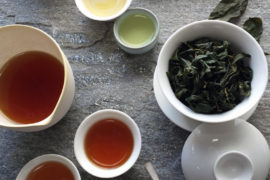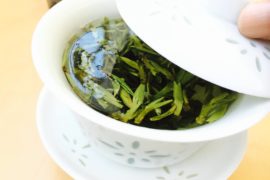Tea making is an art, and the more one masters the basic fundamentals of technique, the more one can free flow and adapt. Of course, we are referring to the art of steeping whole leaf, preferably artisan made teas. Incidentally, water, equipment, and serving vessels are all important supporting characters to the actual tea ingredient itself.
Choose the tea you want to steep by its quality first, then seasonality second. High quality leaves will stand up to storage and time much better than tea dust and fannings, which are usually, not fresh. Once you have chosen the tea you wish to steep, prepare the following:
- Water: Choose spring waters, or carbon-filtered water. Higher mineral waters are usually preferred.
- Temperature: Heat up the water to the right temperature for the appropriate tea. The temperature range for most green teas are between 150-170 F, for White teas between 170-180 F, Oolongs from 190-205 F, and Black and Pu-erh at 205 F. Use a thermometer or a kettle that has temperature settings.
- Kettle selection: Preferably choose one with a gooseneck that aerates the water well as it pours.
- Tea vessel: A smooth porcelain gaiwan (covered tea bowl with lid and saucer) works best for most teas, though it is a bit of a learning curve to handle one. Another option is a porcelain teapot with either a filtered spout, or with a large steeping basket to give it ample room to steep. Avoid metals, such as tetsubin cast iron teapots, or even stainless steel materials.
- Tea cups: White, porcelain teacups with a thin, flared lip are recommended. Generally, each teapot or vessel should serve about 4 of those cups, so that you can portion correctly.
- Drain tray: It is advisable to set your steeping vessel on a drain tray, or at least a serving tray, so you can pour freely without worry.
Let’s use an oolong tea as an example, such as the Tieguanyin.
For a tea like Tieguanyin, an authentic unglazed Yixing teapot is preferable. First, heat up your water, and fill your teapot or gaiwan and serving cups. Wait a few minutes till the teapot or gaiwan has warmed up, then discard water. Measure out approximately 4 gms of leaves to an 6 oz. vessel. If you do not have a scale to measure the weight of the leaves, then abide by the following visual rule: For condensed, pearl shaped tea leaves, fill the pot 1/3 with tea leaves and the rest with water. For large, wiry leaves, the vessel should be filled to half.
Pour a small amount of hot water into the vessel, just covering the leaves, and discard immediately. This is called the Rinse, or Waking the Leaves, procedure. This process gets the leaves to warm up, and then steep properly when the correct temperature water is applied.
Fill the gaiwan to the curved rim with hot water. If you have a gooseneck kettle, aerate and move the tea leaves by applying a high pour. If you are filling a Yixing clay teapot, be sure to fill the teapot until it overflows, then press the lid down to close. This will eliminate any air space inside the teapot, allowing for the temperature to stay consistent.
Steeping times vary for different teas. Green teas for example, should all be around 1 minute. For oolong teas like the Tieguanyin, steep for slightly more than a minute. Move the teas with your lid, if possible, midway. For a Yixing teapot, pour hot water outside the body of the teapot to bathe the pot and keep it warm.
In about 1 minute and 15 seconds or so, decant the entire amount of tea liquid into your serving cups, evenly distributed. You might also want to invest in a server, or a decanting cup, so that all the content is evenly distributed.
Oolongs like Tieguanyin, are good for 6-7 steepings, at around 1 minute each steeping. Usually, the first 3 steepings offer the best levels of aroma and body, and trailing fragrance on the finish.
Enjoy the fruits of your labor! If you have paid attention to the details of the steeping process, your cup of tea should turn out near perfect. Developing your own special techniques will be that much more rewarding once you have mastered these basics. It’s like making your own, personal signature version of bouillabaisse, or recalling a special blueberry pie that one identifies with grandma. Some tea makers will bring out the floral, pretty notes of the tea best, and others, the deep, resonant complexities. The hand of the chef, or the tea maker, plays a big role in what kind of experience each pot of tea will call forth.










Comments are closed.